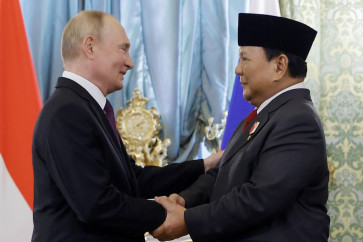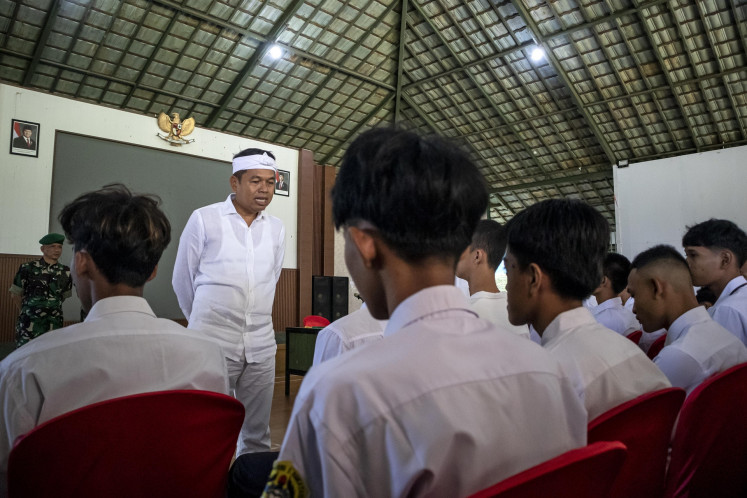Pertamina predicts gas deficit in 2035
Indonesia will produce less liquefied natural gas (LNG) than it consumes 16 years from now as local demand moves up along with economic growth, state energy giant Pertamina says
Change text size
Gift Premium Articles
to Anyone

I
ndonesia will produce less liquefied natural gas (LNG) than it consumes 16 years from now as local demand moves up along with economic growth, state energy giant Pertamina says. But the government remains confident it “will never import” gas.
Even taking into account rich gas blocks such as the Masela Block, Jambarang Tiung Biru field (Cepu Block), Tangguh field (Berau Block) and Sakakemang Block, Indonesia will face an LNG deficit of 1,000 to 2,000 million metric standard cubic feet per day (mmscfd) by 2035, according to Pertamina estimates.
“The deficit prediction has included the production of giant gas blocks,” said Heru Setiawan, Pertamina director of investment planning and risk.
Indonesia is currently an LNG exporter with exports reaching 1,907 billion British thermal units per day (bbtud), or almost five times the average volume of domestic LNG utilization at 405.2 bbtud. Of the country’s LNG production last year, 28 percent was exported, 25 percent for industry, 25 percent for electricity and 11 percent for fertilizer.
Pertamina’s forecast is in line with a recent report from global energy think tank Wood Mackenzie, which stated that LNG demand from Southeast Asia would grow over five times to reach 236 million tons per annum (mmtpa) by 2040.
“Almost half of that demand will come from the two major markets of Indonesia and India,” Wood Mackenzie principal analyst Asti Asra said in an e-mail. “Indonesia’s LNG demand is coming from the power sector.”
Domestic demand for LNG is expected to rise from power plant projects from state electricity firm PLN, petrochemical projects and refinery projects. Pertamina will develop at least six refinery assets in the future.
Pertamina’s refinery projects, with total investment planned at around US$45 billion, is targeted to commence operation seven years from now in 2026.
“Hence, we will have to import LNG or expect new production from current exploration projects, such as the Indonesia Deepwater Development [IDD], Merakes field and West Ganal Block,” Heru said.
In total, the three blocks could produce at least around 1,391 mmscfd, 391 mmscfd of which is expected to come from Merakes gas field, East Sepinggan Block, which is operated by Rome-based energy firm ENI S.p.A, which aims to start producing oil in 2021.
Meanwhile, the IDD project and West Ganal Block are still finalizing their development plans and have yet to be acquired by any oil and gas contractors.
Pertamina’s expectation to have a new gas supply to offset the lack of supply in 2035 from the IDD project is still uncertain as Upstream Oil and Gas Regulatory Special Task Force (SKKMigas) chairman Dwi Soetjipto said the project’s contractors were still discussing the economic aspects.
“IDD is still in discussion regarding the project’s economic viability in the consortium, which is comprised of Chevron, ENI S.p.A and Sinopec,” he said on Wednesday.
Commenting on the gas deficit issue, Energy and Mineral Resources Minister Ignasius Jonan remained upbeat that the country would not import gas, except only for liquefied petroleum gas (LPG).
“We’ll never import gas,” minister Jonan said. “The prediction of the gas deficit was made before we found new blocks,” he said, referring to the previous in-house prediction made by the ministry.
The previous ministry estimate suggested a shortage in the national gas supply by 2025 and a deficit two years after.
Mamit Setiawan, executive director of local energy think tank Energy Watch, doubted that in sixteen years the country would be in gas deficit due to the current slow absorption of gas in the electricity sector.
“Our electricity demand growth is still stagnant. The 35,000 megawatts project has yet to be completed and most of [the power plants] still use coal,” he told The Jakarta Post.
Mamit also concurred with minister Jonan's view that the import of LNG could be avoided if strategic gas projects such as the Masela Block by Japan-based energy firm Inpex started to produce according to the target in 2027.









